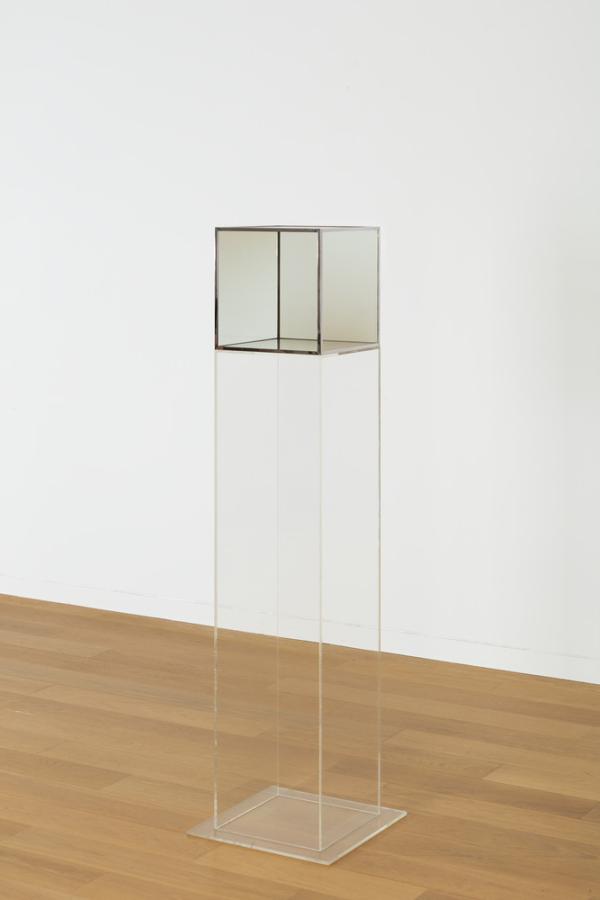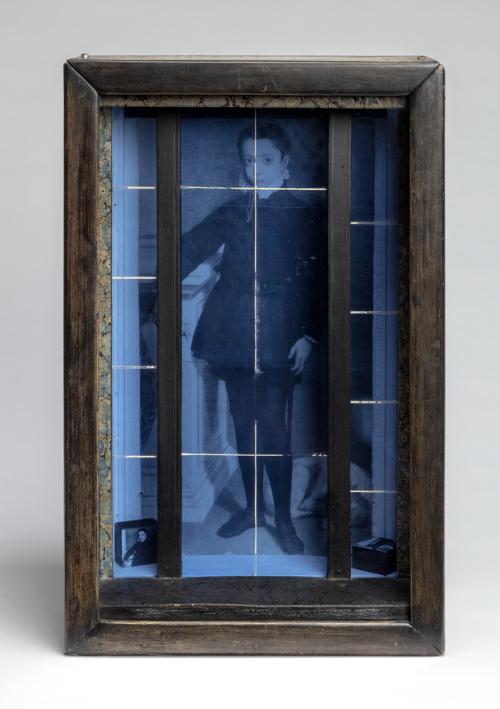Skip to main content
Untitled from Terminal Series
Artist
Larry Bell
(Born 1939, United States)
Date1968
MediumGlass and chrome
DimensionsOverall: 12 1/8 x 12 1/8 x 12 1/4 in. (30.8 x 30.8 x 31.12 cm)
Credit LineCollection of the Modern Art Museum of Fort Worth, Museum purchase, The Benjamin J. Tillar Memorial Trust
Object number1968.18
Status
Not on viewInscribednone
Copyright© Larry Bell
Category
Label TextLarry Bell’s glass cube manifests the “less is more” aesthetic that drove much twentieth-century geometric abstraction. Reducing compositional elements to a minimum is, however, a risky artistic endeavor; viewers often find the work too simplistic. Artists, however, have conceived reductivism as a means to distill form to a purer essence and to produce a work that can induce a contemplative attitude. As Bell’s Untitled, 1968, demonstrates, condensing form can also intensify perceptual experience.
Untitled sits on a thirty-eight-inch-high Plexiglas pedestal. The base’s transparency, which allows light to enter the cube from below, contributes to a sense that Untitled is floating in space. At the same time, the pedestal is clearly a sculptural support and, as such, signals that it is elevating a work of art (rather than merely holding a glass box). The cube is an immaculate fabrication of smoke-colored glass framed by chrome strips. To achieve the tinting, Bell employed a High Vacuum Optical Coating Machine, originally manufactured for the United States Air Force to coat the glass surfaces of fighter-plane cockpits. This vacuum allowed the artist to chemically bind four extraordinarily thin layers of atomized mineral and metal compounds to the glass. Bell aimed to achieve a gradient coating that would fade from the edges toward the center of each pane. This, and the shifting nuances of color and light that the artist intended, are less evident in Untitled than in other works in the Terminal Series. Instead, Untitled’s greater overall surface and formal consistency evince a wholeness and perfection.
Bell aimed for a pristine state in order to eliminate any distractions to the viewer’s perception of the piece. His concern relates directly to the “finish fetish” and “light and space” aesthetic characterizing the LA Look of the 1960s. His glass cubes coincided with the emergence of Minimalism, and his work is often considered in the context of that movement. Like Minimalist art, Bell’s forms display clarity, nonreferentiality, factory fabrication, and literalness. But where the Minimalists asserted the phenomenological presence of the object, Bell emphasized its perceptual complexities and subtleties.
Untitled sits on a thirty-eight-inch-high Plexiglas pedestal. The base’s transparency, which allows light to enter the cube from below, contributes to a sense that Untitled is floating in space. At the same time, the pedestal is clearly a sculptural support and, as such, signals that it is elevating a work of art (rather than merely holding a glass box). The cube is an immaculate fabrication of smoke-colored glass framed by chrome strips. To achieve the tinting, Bell employed a High Vacuum Optical Coating Machine, originally manufactured for the United States Air Force to coat the glass surfaces of fighter-plane cockpits. This vacuum allowed the artist to chemically bind four extraordinarily thin layers of atomized mineral and metal compounds to the glass. Bell aimed to achieve a gradient coating that would fade from the edges toward the center of each pane. This, and the shifting nuances of color and light that the artist intended, are less evident in Untitled than in other works in the Terminal Series. Instead, Untitled’s greater overall surface and formal consistency evince a wholeness and perfection.
Bell aimed for a pristine state in order to eliminate any distractions to the viewer’s perception of the piece. His concern relates directly to the “finish fetish” and “light and space” aesthetic characterizing the LA Look of the 1960s. His glass cubes coincided with the emergence of Minimalism, and his work is often considered in the context of that movement. Like Minimalist art, Bell’s forms display clarity, nonreferentiality, factory fabrication, and literalness. But where the Minimalists asserted the phenomenological presence of the object, Bell emphasized its perceptual complexities and subtleties.








